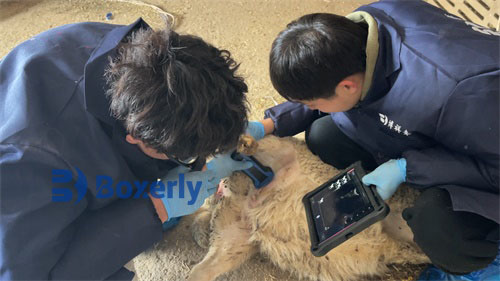Various problems may arise during the use of sheep ultrasound machines, including common misunderstandings and errors in ultrasound diagnosis of pregnancy in sheep and goats. Below are five aspects to pay attention to when using a sheep B-ultrasound machine
1. Diagnosis time of sheep using B-ultrasound machine
Although transrectal ultrasound can be used to diagnose pregnancy as early as 20 days ago, most examinations are performed using non-invasive transabdominal methods. Experienced practitioners begin to be satisfied with this technology around 30-35 days, but many prefer to schedule preliminary examinations around 45 days. At this point, the fetal and placental structures are more developed, the fetal heartbeat is easily distinguishable, and the likelihood of pregnancy is significantly reduced, but the uterus is still small enough to calculate multiples.
2. Preparation work
Carefully select sensors that are suitable for the job. For example, some people like to use EVO C6E transducers because of their high resolution and small footprint, but most large varieties will benefit from low-frequency tools like CL3E or CLi3E, whose power and penetration depth can reach up to 30 centimeters.
Make sure you have enough contact media (I usually only use alcohol, but acoustic gel, OB lubricant, and even hand sanitizer can also be used). If you are using varieties with dense coatings and want to obtain * * * best images, please consider using scissors. Sheep usually have a thick layer of lanolin coating in the breast area, so wiping wax debris with a towel will help ensure adequate contact.
3. Detecting location
Based on experience, most pregnancy diagnoses are made through the right-sided method to avoid image obstruction caused by the rumen. Starting from the relatively hairless inguinal area, leave it on the side of the breast and scan inward. Non pregnant uterus or early pregnancy may be found far away in the pelvis, only on the dorsal side of the bladder, but in late pregnancy, you will find that a uterus filled with fluid is more prone to skull movement. According to user preferences and facility/constraint design, the positioning of the probe can be done from the flank area (lateral approach) or from between the hind legs. If pregnancy is suspected but not seen, scanning from the left side is also a good idea to ensure that small embryos are not missed
4. Using B-ultrasound to determine the survival ability of the fetus
By using sheep ultrasound machines early enough during pregnancy to observe the fetus or fetus as much as possible, you should be able to determine the condition of pregnancy to a reasonable extent. Search for fetal movement, consistent fetal heartbeat, and normal, recognizable anatomical structures. The liquid should be relatively black; The 'snowglobe' effect may indicate a higher degree of cellular debris in the placenta than normal. Similarly, using a B-ultrasound machine for sheep is very useful for identifying hydraulic effects or mucometra ("false pregnancy", common in goats) - you will see a uterus filled with fluid but lacking a fetus and placenta. Ultrasound is crucial for monitoring fetal death in high-risk pregnancies or cases of pregnancy toxemia (ketosis).
5. Using sheep and B-ultrasound machine to confirm counting of fetuses
Many owners or producers of small ruminants are very interested in knowing if their animals carry multiple fetuses. These pieces of information help guide their nutrition plan and prepare for possible difficult childbirth. Although sheep ultrasound has many advantages, it is not an ideal diagnostic tool due to its dynamic characteristics. Due to the continuous movement of the transducer, it is easy to count the same fetus twice! Unfortunately, X-ray images are not practical for most sheep and goats, so we try our best to use ultrasound calculations. This * * * can be completed within 45 to 90 days, but it is still not always very accurate. Patiently scan from both sides and search for multiple views of children or lambs on the same screen. Be careful when scanning through a plane with two parts of the same fetus - if you see the head and hind legs very close, be aware that they may belong to the same body. A lot of practice will make you more confident, but take your counting as a general guide and don't rely on them.








